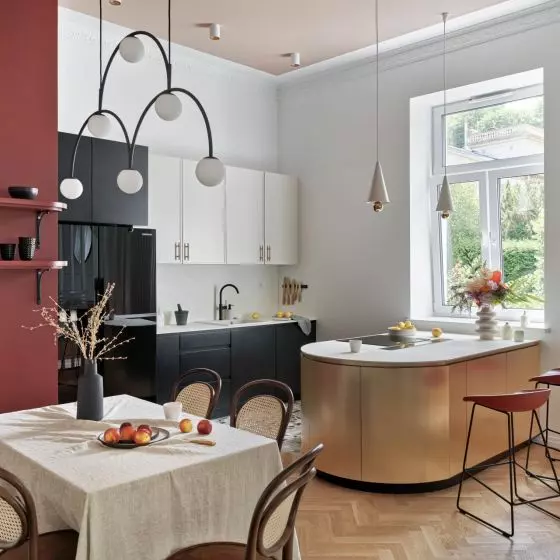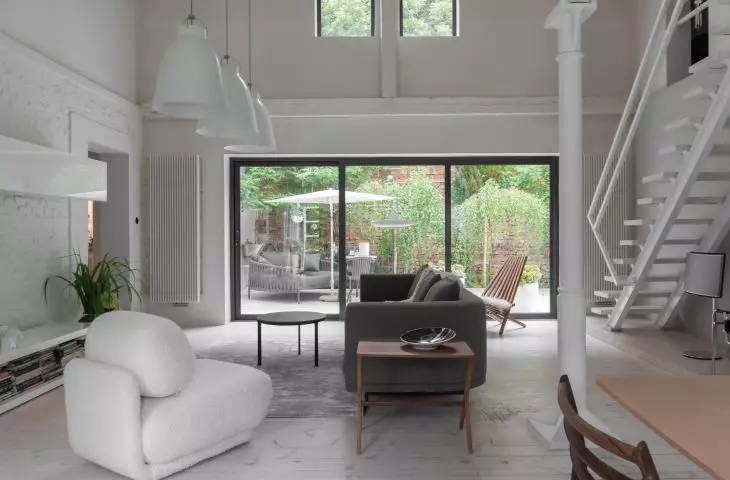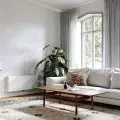Can a ruin and a building left over from an old smithy be converted into a house? Yes! The interior adaptation was undertaken by designers from the studio Loft Kolasinski in Szczecin implementation.
The color scheme of the interior is dominated by white
Photo: Karolina Bąk, © Loft Kolasinski
The owners bought the building in a dramatic condition that could only be described in one word - ruin. Before World War II, the building was a blacksmith shop and a small room for seasonal workers who worked in the orchard surrounding the building. The first adaptation work completed in 2009 took two years.
In the beginning there was a ruin...
The house of one hundred and forty square meters is adjoined by an enclosed patio, which was separated from the neighboring buildings by a wall made of bricks. The main goal of the designers, was to create an open space that illusorily gives the impression of being much larger. The first step to achieve this effect was to eliminate part of the ceiling over the living room, which allowed the ceiling to be raised to a height of six meters.
A small patio adjoins the house, separated from the development by a brick wall
Photo: Karolina Bąk, © Kolasinski Loft
An important element was to preserve the original architectural elements inside the building. The walls were covered with natural plaster were painted with white paint with a touch of gray pigment. In some places it was decided to leave the brick walls painted.
looking for new inspiration
After twelve years of using the house, the owners decided to make new partial changes, which were again designed by interior architects from the Loft Kolasinski studio. At that time, the floorboards in the patio were replaced, and the bathroom received a new arrangement and furnishings. An important element was to find additional work space in the sleeping area. The desk was designed by Loft Kolasinski studios.
The designers were keen to preserve as much as possible
Photo: Karolina Bąk, © Loft Kolasinski
The biggest changes were in the living room. Gray and brown furniture was introduced into the white-dominated space. An important element of the interiors of the house adapted in the Forge is a collection of various chairs from Denmark. The owners have furniture designed by Kofod Larsen, Niels Otto Møller, Harry Østergaard, Bruno Mathsson and Hans Jorgensen Wegner, among others.
Also important is the garden and patio, which is overgrown with greenery. The surroundings are full of small trees, vines, flowers planted in the ground and in pots, creating a pleasant, enclosed space.
Adapting a dilapidated blacksmith's shop for residential purposes certainly posed a challenge for adaptation. The interior architects succeeded in creating a space indicative of the building's origins and character, while also having a modern, loft-like feel that acts as a home and allows for the display of a unique collection of Danish chairs.
Chairs are essential home furnishings
© photo by Karolina Bak, © Loft Kolasinski
The designer, Jacek Kolasinski, talks about the concept, the history of creation.
Wiktor Bochenek: This realization is distinguished primarily by the adaptation of the interior in a building that was practically a ruin. How did this influence the design process?
Jacek Kolasinski: This project is a special case, because the investor was me, I live here with my family. Since the condition of the building was bad, it was necessary to be patient, the assumed renovation time of eight months, extended to two years.
Inside you will find a very interesting art collection
© photo by Karolina Bąk, © Kolasinski Loft
Wiktor Bochenek: How did the work on the building proceed?
Jacek Kolasinski: A number of "surprises" that I encountered required a lot of procedures that I had not planned. Twice the building had to be insulated, the first insulation treatment did not work. Finally, one of the main walls required additional dehumidification.
Connecting the sewage system proved to be a big problem (field requirements). Renovating such an old building requires constant inspection of the renovation crews. Since the project called for preserving as much of the original details as possible, I had to constantly make sure the contractors kept this in mind. The design also called for maximum interior light, and large windows were installed. The largest glazing is adjacent to the patio, which is hidden at the back of the house.
Wiktor Bochenek: What was the most difficult part of this project, and what are you most satisfied with?
Jacek Kolasinski: I'm most satisfied with the effect I achieved by eliminating some of the space on the first floor, so that part of the living room is more than six meters high. The height of the kitchen is seven meters, here I also eliminated the ceiling.
Wiktor Bochenek: Thank you for the interview.
view of the living room and patio
© photo by Karolina Bąk, © Kolasinski Loft



























































